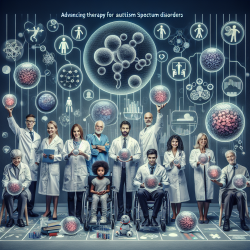Introduction
In the realm of speech-language pathology, leveraging data-driven insights can significantly enhance therapeutic outcomes for children. A recent study titled "Generating Clustered Journal Maps: An Automated System for Hierarchical Classification" provides a novel approach to understanding scientific communication through the visualization of journal connections. This blog explores how practitioners can apply these insights to refine their practices and encourage further research in the field.
Understanding the Research
The study by Leydesdorff, Bornmann, and Wagner (2017) introduces a method for visualizing journal-to-journal connections, creating what they refer to as 'macro-epistemics.' This approach utilizes VOSviewer, a tool for generating quasi-deterministic classifications, to map and cluster journals based on citation patterns. The resulting visualizations offer a comprehensive view of scientific communities and their interconnections.
Implications for Speech-Language Pathology
For practitioners in speech-language pathology, this research presents several opportunities:
- Enhanced Literature Review: By utilizing journal maps, practitioners can identify key journals and articles relevant to their specific areas of interest, ensuring a more targeted and efficient literature review process.
- Interdisciplinary Collaboration: Understanding the connections between journals can highlight potential interdisciplinary collaborations, fostering innovative approaches to therapy.
- Evidence-Based Practice: The ability to visualize journal clusters allows practitioners to align their methods with the latest evidence-based practices, improving therapeutic outcomes for children.
Encouraging Further Research
While the study provides a robust framework for journal classification, it also highlights the need for further exploration. Practitioners are encouraged to delve deeper into the following areas:
- Customization of Journal Maps: Tailoring journal maps to specific subfields within speech-language pathology can yield more precise insights.
- Integration with Clinical Data: Combining journal mapping with clinical data could enhance the understanding of treatment efficacy and patient outcomes.
- Longitudinal Studies: Conducting longitudinal studies to observe changes in journal clusters over time can provide insights into the evolving landscape of speech-language pathology research.
Conclusion
Incorporating data-driven insights from journal mapping into speech-language pathology practice offers a promising avenue for enhancing therapeutic outcomes. By embracing these methodologies, practitioners can stay at the forefront of research, ensuring that their practices are both innovative and evidence-based.
To read the original research paper, please follow this link: Generating clustered journal maps: an automated system for hierarchical classification.










